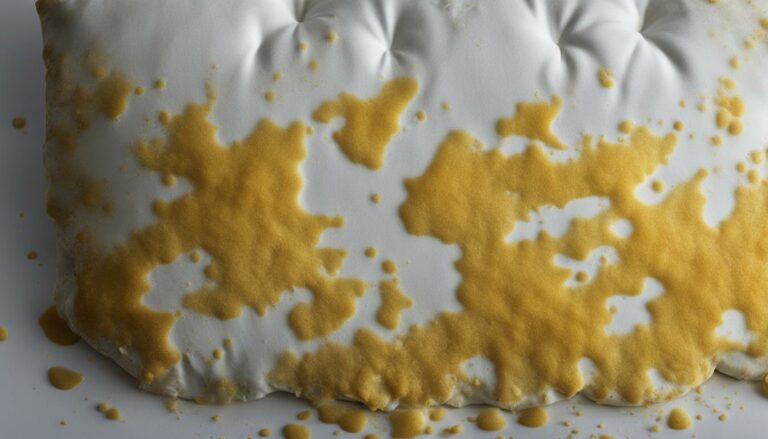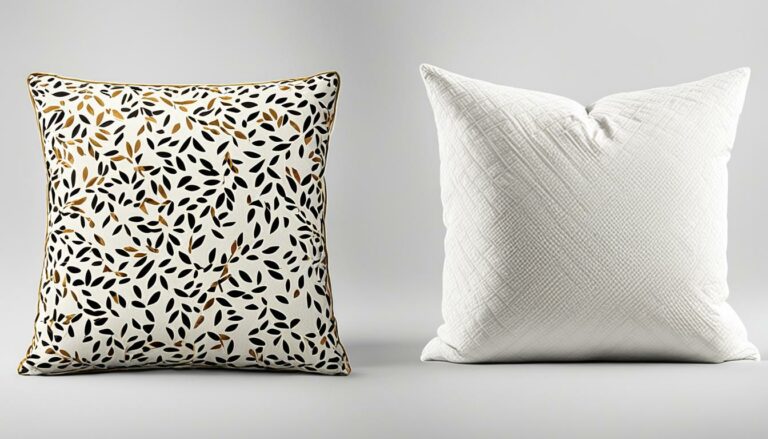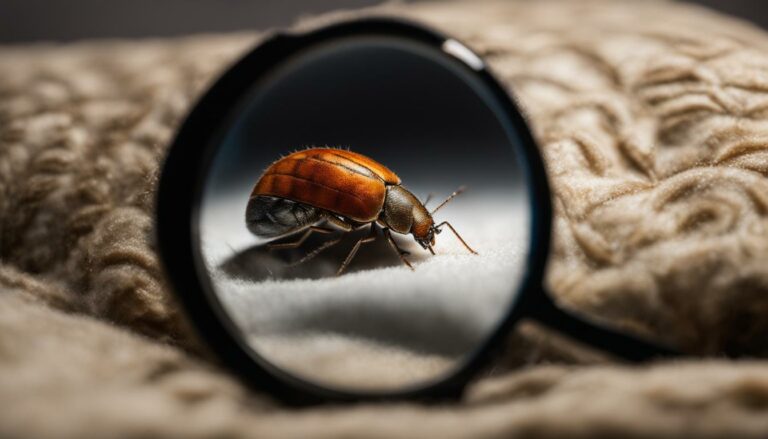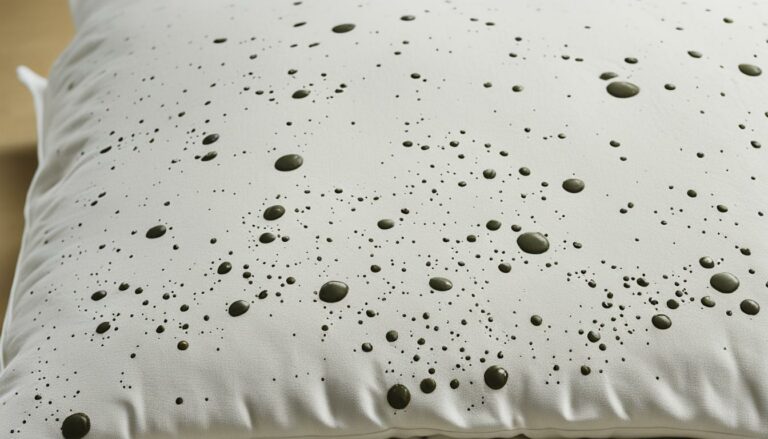Bed Bug Signs on Pillow – Detect Infestation Early
Eric Christie stands as a luminary in the bedding industry, with a career spanning nearly four decades since the early 1980s. His journey through the world of bedding has seen him wear many hats – a manufacturer, designer, and retailer, showcasing his versatility and expertise in Read more...
pillowsandbedsheets.com and its partners may earn a commission if you purchase a product through one of our links
Bed bugs can be a nightmare to deal with, but detecting their presence early on is crucial. By knowing the signs of bed bugs on your pillow, you can take quick action to ensure a pest-free sleep environment. In this article, we will explore the various signs to look out for and what steps to take if you suspect a bed bug infestation.
Key Takeaways:
- Knowing the signs of bed bugs on your pillow is essential for early detection.
- Signs of bed bugs on your pillow include bed bug bites, blood stains on sheets, dark specks, a musty smell, and finding bed bugs or their casing.
- If you find a bed bug or suspect a bed bug infestation, it is crucial to contact pest control or an exterminator for professional assistance.
- Take immediate action to mitigate a bed bug infestation by laundering fabrics, inspecting and removing clutter, and installing mattress encasements or bed bug interceptors.
- It’s important to thoroughly inspect your belongings, including sheets and luggage, to minimize the risk of bringing bed bugs home.
Understanding the signs of bed bugs on your pillow is vital for early detection and effective eradication. Being proactive in identifying these signs can save you from potential infestation and ensure a peaceful night’s sleep. Let’s dive into the specific signs you should be aware of and the necessary steps to take if you suspect a bed bug infestation.
5 Signs of Early Bed Bug Infestation
Bed bugs are notorious pests that can quickly infest your home and disrupt your sleep. Detecting a bed bug infestation early is crucial to prevent a widespread problem. By recognizing the early signs of bed bugs, you can take immediate action to address the issue. Here are five common signs of early bed bug infestation to watch out for:
- Bed bug bites on your skin: Waking up with itchy, red welts on your body can be a clear indication of bed bug presence. Bed bugs feed on human blood and leave behind small, red bite marks that are often arranged in a line or cluster.
- Blood stains on your sheets: Bed bugs get engorged with blood after feeding, and when you move in your sleep, they may get crushed, leaving behind small blood stains on your pillow or sheets.
- Finding dark specks on your sheets: Bed bugs produce dark fecal spots as a result of their feeding habits. These spots are tiny, black or brown in color, and may appear on your sheets or mattress.
- A musty smell around your mattress: Bed bugs release pheromones, which can give off a distinct, sweet, musty odor. If you detect an unusual smell around your mattress, it’s important to investigate further.
- Finding a bed bug or their casing: The most definitive sign of a bed bug infestation is actually seeing a live bed bug or their shed exoskeleton. Adult bed bugs are small, oval-shaped insects, while their casings are translucent with a yellowish tint.
Being aware of these early signs of bed bug infestation, especially on your pillow, is crucial in taking prompt action to control the problem. If you suspect a bed bug infestation, it’s recommended to consult with a professional pest control service to effectively eliminate these pests from your home.
Bed Bug Bites On Your Skin
One of the most common signs of a bed bug infestation is bites on your skin. Bed bug bites appear as small, red welts that can be itchy. These itchy red welts are caused by an allergic reaction to the bed bug’s saliva when it bites. If you wake up with a series of welts in a row, it’s a key indicator of bed bug bites.
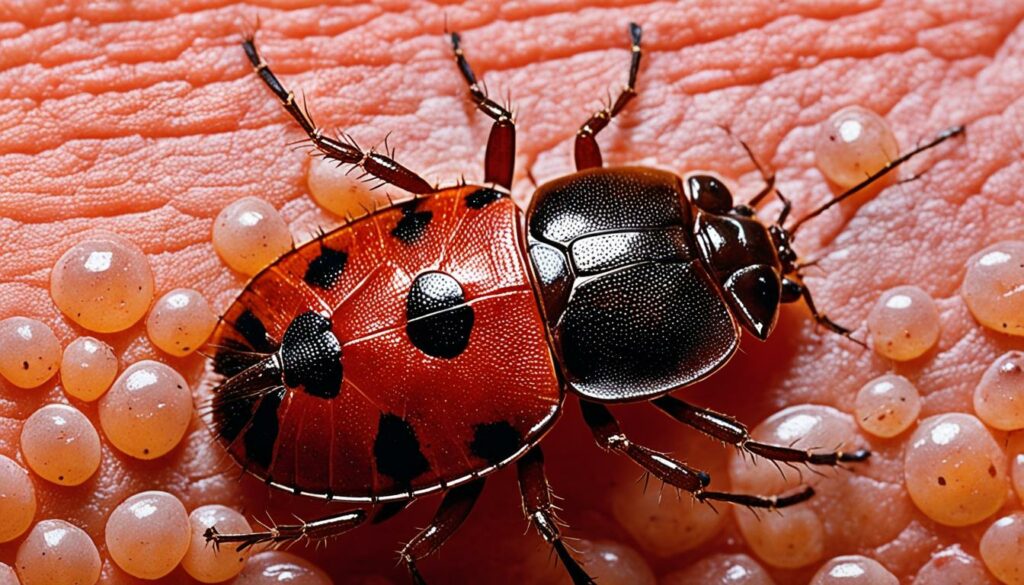
However, it’s important to note that not everyone reacts to bed bug bites in the same way. Some people may not have any noticeable reaction at all, making it possible to have an infestation without experiencing bites. On the other hand, some individuals may have a more severe allergic reaction to bed bug bites, resulting in hives or other allergic reactions.
It’s crucial to pay attention to any unusual welts or skin reactions, especially if they appear in a series or are accompanied by other signs of a bed bug infestation. If you suspect you have bed bug bites, it’s essential to take action to address the infestation and prevent further bites.
Blood Stains On Your Sheets
Another telltale sign of bed bugs on your pillow is the presence of blood stains on your sheets. These stains can be a result of a bed bug biting you during the night, leaving behind fresh blood stains on the fabric. When a bed bug feeds on your blood, some of it may remain on your skin and transfer onto the sheets when you move. This can cause noticeable stains that are often reddish or brownish in color.
Additionally, if you accidentally crush a bed bug while sleeping, it can leave behind blood stains on your sheets. Bed bugs are small and easily squashed, releasing their blood content when compressed. These crushed bed bugs can leave behind distinct blood smears on the sheets.
It’s important to note that the presence of blood stains on your sheets alone may not be enough to confirm a bed bug infestation. Other signs such as bed bug bites, dark specks, or finding live bed bugs or their casings should also be considered for a more accurate diagnosis.
Bed Bug Infestation Signs on Sheets
| Sign | Description |
|---|---|
| 1. Blood Stains | Reddish or brownish stains on the sheets caused by bed bug bites or accidentally crushing bed bugs. |
| 2. Dark Specks | Black or brown spots on the sheets resulting from bed bug droppings. |
| 3. Small Eggshells | Tiny, translucent eggshells left behind by bed bugs. |
Regularly inspecting your sheets for these signs can help you detect a bed bug infestation early on and take appropriate action.
Finding Dark Specks On Your Sheets
As a bed bug infestation progresses, you may start to notice dark spots on your sheets. These spots can range in color from black to brown and can appear in clusters if the infestation is newer or more spread out if it has been going on for a while. These dark spots are the result of bed bug droppings and crushed bugs.
If you suspect bed bugs, inspect your sheets carefully for these dark specks. You may find them in areas where the bugs are hiding, such as the seams and edges of your mattress or near the headboard.
Take a close look at the dark spots. Are they small, round, and scattered in clusters? If so, it’s likely bed bug droppings. These droppings consist of digested blood and are a telltale sign of a bed bug infestation.
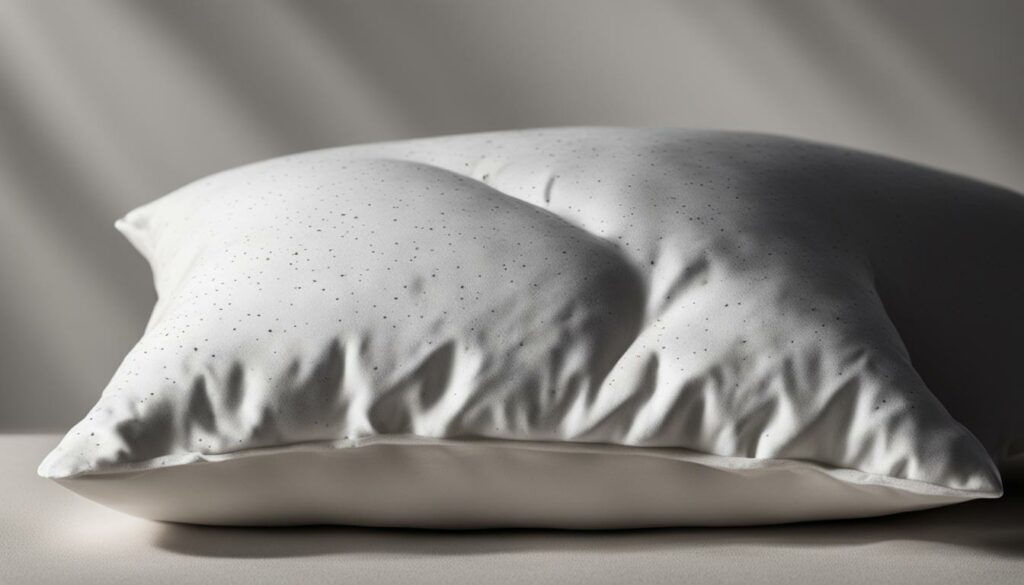
Musty Smell Around Your Mattress
If you detect a strange, musty smell around your mattress with no apparent source, it could be a sign of a bed bug infestation. Bed bugs emit pheromones as they settle in, and this can create a distinct smell. The smell can vary, with some people describing it as sweet, while others find it unpleasant. However, it’s important to note that the odor alone is not enough to confirm a bed bug infestation as it could be caused by other factors as well.
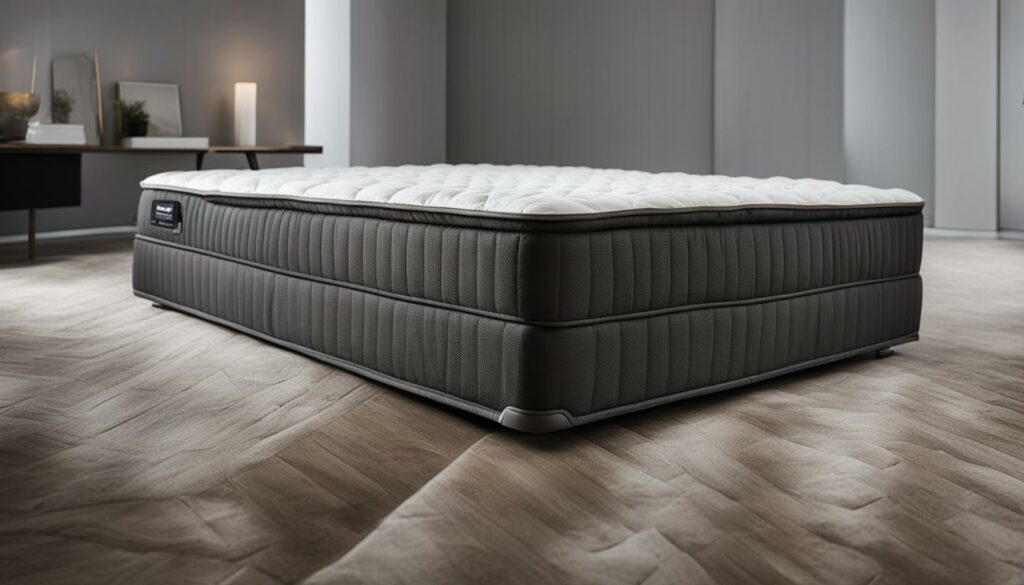
If you have noticed a musty smell around your mattress, it’s important to thoroughly inspect your bedding and mattress for other signs of a bed bug infestation, such as dark spots, blood stains, or actual bed bugs. By conducting a thorough examination, you can determine the presence of bed bugs and take appropriate measures to address the infestation, if necessary.
Finding A Bed Bug or Casing
The most definitive sign of a bed bug infestation is actually finding a live bed bug or their casing. Adult bed bugs are small and brown, resembling the shape of an apple seed. Their casings, or shed exoskeletons, can vary in size and are often translucent with a yellow tint. If you come across a live bed bug or their casing, it is important to contact pest control or an exterminator.
Recognizing Bed Bug Casings
Bed bug casings are an important clue that can help confirm the presence of an infestation. These casings are the exoskeletons that bed bugs shed as they grow. To recognize bed bug casings, look for:
- Translucent appearance with a yellowish tint
- Varying sizes, depending on the life stage of the bed bug
- Presence near their hiding spots, such as in cracks, crevices, and mattress seams
Bed bug casings can accumulate over time and provide evidence of an ongoing infestation. If you discover multiple casings in your home, it’s crucial to take immediate action to address the problem.
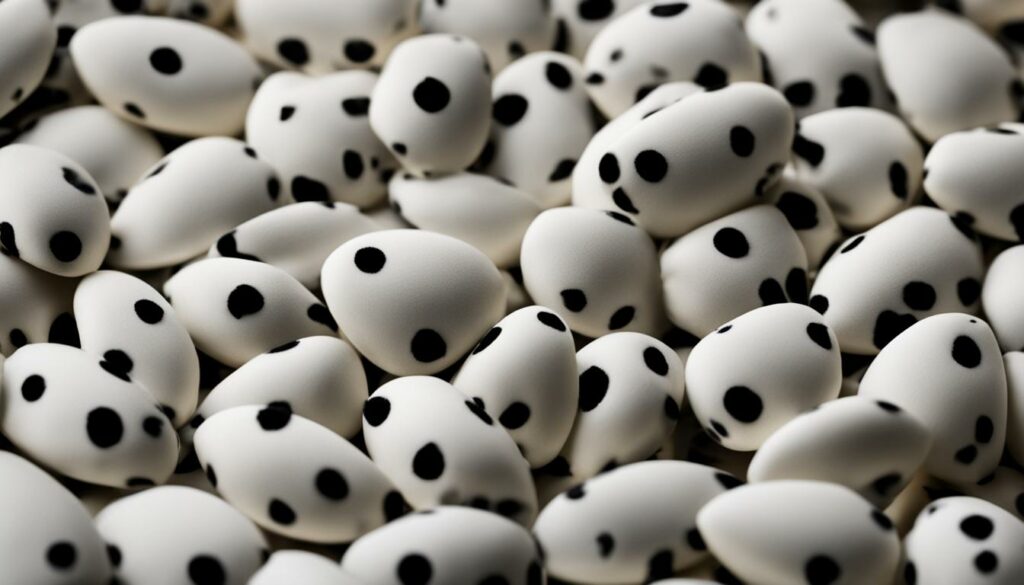
Description of Bed Bugs and Their Casings
Bed bugs are small, oval-shaped insects that are primarily nocturnal, feeding on the blood of humans. Here are some key characteristics of bed bugs:
| Characteristic | Description |
|---|---|
| Size | Adult bed bugs are typically around 4 to 5 mm long, similar to the size of an apple seed. Nymphs, which are younger bed bugs, are smaller and lighter in color. |
| Color | Adult bed bugs are reddish-brown, becoming darker after feeding. Nymphs are translucent to light yellow in color. |
| Shape | Bed bugs have a flat, oval-shaped body with six legs. They have a distinct beak-like mouthpart for piercing the skin and feeding. |
| Behavior | Bed bugs are excellent hitchhikers and can easily travel from one location to another by clinging onto clothing, luggage, or furniture. |
| Life Cycle | Bed bugs go through multiple stages of development, starting as eggs that hatch into nymphs. Nymphs undergo several molts before reaching adulthood. |
Understanding the physical characteristics of bed bugs and their casings can help you in identifying and confirming an infestation. If you come across live bed bugs or their casings, it is crucial to take swift action to prevent the infestation from spreading further.
What to Do If You Find a Bed Bug
If you have discovered a bed bug or suspect a bed bug infestation in your home, it’s crucial to take immediate action. Here are the steps you should follow:
- Contact Pest Control: First and foremost, reach out to your local pest control company or an exterminator that specializes in bed bug infestations. They have the expertise and tools to effectively eliminate bed bugs from your home.
- Mitigate the Infestation: If you’re unable to get immediate assistance from a professional, there are a few steps you can take to mitigate the infestation until help arrives. These include:
- Find Bed Bug Harborage Sites: Inspect your home thoroughly to identify the areas where bed bugs are most likely to hide. Focus on mattresses, box springs, bed frames, and upholstered furniture.
- Launder Fabrics on High Heat: Wash all bedding, clothing, and fabrics that may have come into contact with bed bugs in hot water and dry them on high heat. This will help kill any bed bugs or eggs present.
- Inspect and Remove Clutter: Declutter your home to eliminate potential hiding places for bed bugs. Pay special attention to areas where clutter tends to accumulate, such as closets, under the bed, and in storage areas.
- Install Mattress Encasement or Bed Bug Interceptors: Consider using mattress encasements and bed bug interceptors to prevent bed bugs from accessing your bed and to monitor their presence.
Remember, while these steps can help reduce the infestation temporarily, it’s essential to seek professional assistance to fully resolve the bed bug problem in your home.
“Taking immediate action is crucial when dealing with a bed bug infestation. Contacting pest control and following mitigation steps can help prevent the infestation from spreading and minimize discomfort in your home.”
Can You Bring Bed Bugs Home?
When it comes to bed bug infestations, prevention is key. It is possible to bring bed bugs home from various sources, including hotels. Bed bugs are excellent hitchhikers and can hide in your luggage or personal belongings, making it easy for them to find their way into your home.
To minimize the risk of bringing bed bugs home, it’s important to be vigilant and take precautionary measures. If you are staying at a hotel, always inspect your room thoroughly before unpacking. Pay close attention to the mattress, headboard, and furniture, as these are common hiding spots for bed bugs.
Additionally, when you’re ready to leave the hotel, inspect your belongings carefully to ensure you don’t inadvertently bring any bed bugs with you. Shake out your luggage, inspect your clothing, and use a flashlight to check for any signs of infestation.
It’s important to note that bed bugs can also be picked up from other sources, such as public transportation, movie theaters, and even other people’s homes. So, it’s essential to remain cautious and proactive in protecting your living space.
Infestation Timeline
It’s crucial to understand the timeline of a bed bug infestation. After bringing bed bugs into your home, it may take several weeks or even months for signs to become apparent. Bed bugs are known to be elusive and may hide in cracks and crevices, making them difficult to detect.
Below is a timeline of a typical bed bug infestation:
| Timeline | Activity |
|---|---|
| 0-8 weeks | Bed bugs breed and multiply, spreading throughout your home. |
| 4-12 weeks | Infestation becomes more noticeable as bed bugs reproduce and increase in numbers. |
| 12-16 weeks | Signs of infestation, such as bites and dark spots on bedding, become more prevalent. |
| 16+ weeks | Infestation reaches its peak, and it becomes more challenging to control and eliminate the bed bugs. |
It’s important to act swiftly if you suspect a bed bug infestation. Contact a professional pest control company to assess the situation and recommend appropriate treatment options.
Remember, early detection and prevention are key in avoiding the headache of a full-blown bed bug infestation in your home.
How Can I Tell if My Sheets Have Bed Bugs?
Bed bugs typically hide in your mattress or box spring, but their signs can also be found on your sheets. Thoroughly inspecting your sheets can help you determine if you have a bed bug infestation.
Signs of bed bugs in sheets:
- Dark stains: Look for dark stains that resemble fecal spots or bloodstains on your sheets. These stains are caused by bed bug droppings or when a bed bug is crushed while feeding.
- Eggshells: Keep an eye out for small, translucent eggshells on your sheets. Bed bugs lay eggs in hidden areas, which can include the creases and folds of your sheets.
- Shed skins: Bed bugs shed their exoskeletons as they grow. Look for tiny, shell-like skins on your sheets, which are a sign of an active infestation.
These signs may appear as clusters or random patterns on your sheets. It’s important to inspect your sheets carefully, especially in the seams and corners, as bed bugs tend to hide in these areas.
If you discover any of these signs on your sheets, it’s crucial to take immediate action to eliminate the infestation and prevent bed bugs from spreading further.
| Signs of Bed Bugs in Sheets | Description |
|---|---|
| Dark Stains | Resemble fecal spots or bloodstains caused by bed bug droppings or crushed bugs |
| Eggshells | Small, translucent shells left behind by bed bug eggs |
| Shed Skins | Tiny, shell-like skins shed by bed bugs as they grow |
Can Animals Bring Bed Bugs Into Your Home?
While it is possible for animals such as dogs and cats to carry bed bugs into your home, it is relatively rare. Bed bugs do not live in fur like fleas do, so the likelihood of them starting on your pet is low. If you do find bed bugs on or around your pet, it’s more likely that they were picked up from the environment rather than being the source of the infestation.
Bed bugs are opportunistic pests that can hitch a ride on clothing, luggage, and personal belongings. They are expert travelers and can easily infest new areas, including your home. While animals can inadvertently transfer bed bugs, they are not the primary carriers.
To prevent bed bugs from entering your home, it’s essential to take precautions when traveling or visiting places where bed bugs may be present. Inspect your luggage, clothing, and belongings thoroughly to ensure you are not inadvertently bringing home these unwanted pests. Additionally, regularly vacuuming and cleaning your home can help minimize the risk of a bed bug infestation.
Expert Advice: Myth or Fact?
“Contrary to popular belief, dogs and cats don’t play a significant role in introducing bed bugs to homes. Bed bugs primarily rely on human hosts and are more commonly spread through human activities and transportation.”
| Animals | Bed Bugs | |
|---|---|---|
| Primary Carriers | No | Yes (Human hosts) |
| Living Environment | Fur, feathers, and habitat | In cracks, crevices, and furniture |
| Travel Ability | Can transport bed bugs | Excellent hitchhikers |
| Infestation Source | Environment | Human presence and activities |
| Probability of Infestation | Low | High (Human dwellings) |
As shown in the table above, animals are not the primary carriers of bed bugs. Bed bugs rely on human hosts and are highly adaptable to human living environments. Understanding the true sources of bed bug infestations can help debunk misconceptions and focus prevention and eradication efforts where they are most effective.
Health Issues Caused by Bed Bugs
While bed bugs may not transmit diseases to humans, their bites can lead to a range of health issues. The most common health risk associated with bed bugs is skin reactions. When bed bugs bite, they inject an anticoagulant and anesthetizing agent into your skin, which can cause redness, swelling, and itching. These skin reactions can vary in severity from person to person, with some individuals experiencing mild irritation while others may develop more pronounced symptoms.
Moreover, the presence of a bed bug infestation can also have psychological impacts. Dealing with and living in close proximity to these pests can create a significant amount of stress and anxiety. The psychological toll of a bed bug infestation can result in sleep disturbances, heightened levels of distress, and a decrease in overall well-being. It is crucial to address a bed bug infestation promptly to minimize these health effects and restore peace of mind.
If you are experiencing skin reactions or psychological distress due to a bed bug infestation, it is recommended to seek medical attention and professional pest control services. A healthcare provider can provide appropriate treatment and guidance for managing the skin reactions, while a professional exterminator can effectively eliminate the bed bug infestation. By taking prompt action, you can alleviate the health risks associated with bed bugs and create a healthier living environment.
FAQ
What are the signs of bed bugs on a pillow?
The signs of bed bugs on a pillow include bed bug bites on your skin, blood stains on your sheets, dark specks on your sheets, a musty smell around your mattress, and actually finding a live bed bug or its casing.
How can I recognize early signs of a bed bug infestation?
Early signs of a bed bug infestation can include bed bug bites on your skin, blood stains on your sheets, dark specks on your sheets, a musty smell around your mattress, and finding a live bed bug or its casing.
What do bed bug bites on the skin look like?
Bed bug bites appear as small, red welts that can be itchy. They may appear in a series of three or four welts in a row.
Can bed bug bites cause an allergic reaction?
Yes, some individuals may experience hives or allergic reactions to bed bug bites.
How do blood stains appear on sheets due to bed bugs?
Blood stains on sheets can occur if a bed bug bites you and leaves traces of blood on your skin or if you accidentally crush a bed bug while sleeping.
What are the dark specks on sheets that could indicate a bed bug infestation?
Dark specks on sheets are often the result of bed bug droppings and crushed bugs. These spots can range in color from black to brown.
Why is there a musty smell around my mattress if there are bed bugs?
Bed bugs emit pheromones that can create a distinct musty smell around your mattress.
How can I identify a live bed bug or its casing?
Adult bed bugs are small and brown, resembling the shape of an apple seed. Their casings, or shed exoskeletons, are often translucent with a yellow tint.
What should I do if I find a bed bug?
If you find a bed bug, it is important to contact your local pest control company or an exterminator to have the infestation professionally removed.
Can I do anything to mitigate a bed bug infestation until professionals arrive?
Yes, you can find the harborage sites, launder all fabrics on high heat, inspect and remove clutter, and consider installing a mattress encasement or bed bug interceptors.
Can I bring bed bugs home from a hotel?
Yes, bed bugs can be brought home from various sources, including hotels. It’s important to thoroughly inspect your room before unpacking and your belongings before leaving to minimize the risk.
How can I tell if my sheets have bed bugs?
Signs of bed bugs on sheets include dark spots that look like fecal spots or bloodstains, small eggshells, and shed skins.
Can animals bring bed bugs into my home?
While it’s relatively rare, animals such as dogs and cats can carry bed bugs into your home if they pick them up from the environment.
Are there any health issues caused by bed bugs?
While bed bugs do not transmit diseases, their bites can cause skin reactions such as redness, swelling, and itching. Some individuals may also experience psychological stress and anxiety due to the presence of bed bugs.
Eric Christie stands as a luminary in the bedding industry, with a career spanning nearly four decades since the early 1980s. His journey through the world of bedding has seen him wear many hats – a manufacturer, designer, and retailer, showcasing his versatility and expertise in Read more...


